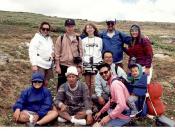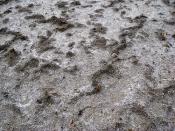Hiking Boot Impacts on Woodland Trails
Fred R. Kuss
Many people have hiked across trails and have never thought about the impact they may have had on the soil they were tramping on. In Hiking Boot Impacts on Woodland Trails we learn that there has been concern about the impact hikers have on the soil. It has been believed that the type of sole on the hikers' boots was a source of damage, that it caused an increase in trail wear. The boots that were of concern were the lug-soled type.
The study conducted involved two types of soles. One was the lug sole type and the other was a corrugated molded rubber compound sole.
The study area consisted of an unused trail system in Hubbard Brook Experimental Forest in New Hampshire with designed controls that took into account slope, intensity of use, canopy, and soil. The soil involved was Madawaska fine sandy loam that is moderately well drained.
The AII horizon was covered with a layer composed of tightly interwoven fibers known as a mor humus layer.
The study was conducted on a series of plots that were separated by buffer strips. Care was taking to insure that only water from overhead would affect the plots and not overland water flow. Collector units were placed at the bottom of each plot in order to collect the run off from the soil. The study also contained two control plots.
After ten days of stabilization hikers weighing 110 and 125 pounds trampled on the plots every seven days for a interval of six weeks at 600 passes per plot on the low intensity plots and 2400 for the high intensity plots, and no passes on the controls.
The materials collected from the plots were air-dried, oven-dried, weighed and compared. Soil cores...



Interesting
This was a very intesting report. Perhaps the original book or study should be sourced. It is impossible to fully critique this piece without that information. Other than that, it is very well written.
4 out of 4 people found this comment useful.